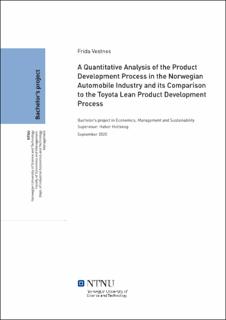| dc.contributor.advisor | Holtskog, Halvor | |
| dc.contributor.author | Vestnes, Frida | |
| dc.date.accessioned | 2021-09-14T17:11:30Z | |
| dc.date.available | 2021-09-14T17:11:30Z | |
| dc.date.issued | 2020 | |
| dc.identifier | no.ntnu:inspera:56121911:58368344 | |
| dc.identifier.uri | https://hdl.handle.net/11250/2777035 | |
| dc.description.abstract | Denne bacheloroppgaven, i Økonomi, ledelse og bærekraft (BØKLED) ved NTNU i Gjøvik, kartlegger den teoretiske bakgrunnen for hvordan Toyota sin Lean-produktutviklingsprosess er implementert og faktorene for at den skal fungere optimalt. Ved en eksplorativ studie ble kvantitativ data om produktutviklingsprosessen i norsk bilindustri benyttet for å danne en modell av denne. Modellen ble brukt for å kunne bedømme hvilke ulikheter og likheter mellom de påvirkende faktorene og de som er avdekket i teorien rundt Toyota sin prosess.
Formål: Finne sammenhenger og påvirkende faktorer i produktutviklingsprosessen hos norsk bilindustri og avdekke ulikheter og likhetstrekk til Toyota sin Lean-produktutviklingsprosess.
Funn: Toyota sin produktutviklingsprosess er forankret i å eliminere ikke-verdi-skapende prosesser. Dette gjøres ved å holde et sterkt fokus på å bla. øke de ansattes kunnskapsnivå, kundens definisjon av verdi, ulike teknologiske løsninger, standardiserte formelle prosesser, kontinuerlig søk etter forbedringsområder. Basert på kvantitativ data brukt i oppgaven, er det mulig å danne en modell for produktutviklingsprosessen til norsk bilindustri.
Begrensninger: Manglende representativt utvalg for alle ulike funksjoner i industrien begrenser modellen for «samtidig» utviklingen i industrien. Da den enkelte bedrifts organisasjonskart ikke er tilgjengelig er muligheten for en sammenligning her begrenset.
Konklusjon: Modellen forklarer de påvirkende faktorene i norsk bilindustri med statistisk signifikans p<0.05. Den viser likhetstrekk med Toyota på følgende punkter: kunderelasjon, kontinuerlig læring og søk etter forbedringer, fokus på å høyne kunnskapsnivået hos de ansatte. Ulikheter som ble avdekket er informasjonsflyten som i diskusjonsdelen blir forklart ved større grad av uformell kommunikasjon i norsk bilindustri. Det viser seg at det ikke er en enkeltperson som er innehaver av Toyota sin «Chief Engineer» rolle, men at dette ansvaret er delt mellom alle team-deltakere. Med dette er det mulig å konkludere at det i enda større grad er sentralt i norsk bilindustri å implementere Lean metoden og tankesettet i alle deler av organisasjonen for å kunne få maksimalt utbytte av den. | |
| dc.description.abstract | This bachelor thesis in Economics, management and sustainability at NTNU in Gjøvik investigates the theoretical background of the Toyota Lean Product Development (LDP) process and the important factors for highest degree of efficiency. Through an exploratory study, quantitative data was used to generate a model of the product development process in the Norwegian automobile industry. The model is then used to assess the differences and similarities between the predicting variables in the product development of Norwegian industry versus the important factors in Toyota.
Purpose: To find a model that can describe the product development process in the Norwegian automotive industry and to uncover differences and similarities to Toyota's Lean product development process.
Findings: Toyota's LDP process has its main focus of eliminating non-value-adding processes. Some of the most important factors of LDP in Toyota is knowledge creation, customer's definition of value, exploring various technological solutions, standardized formal processes, continuous learning. From the exploratory research a model for the product development process for the Norwegian automotive industry was generated.
Limitations: The respondents of the survey may not be representative for all the different functions, which limits the findings related to concurrent engineering. As the organization chart of each company is not available, the comparison to Toyotas structure could not be elaborated on in detail.
Conclusion: The model that has been generated predicts the development process in the Norwegian automobile industry with a statistical significance level of p<0.05. The industry show similarities with Toyota on the following factors: customer relationship, continuous learning and knowledge creation. One of the differences were found to be the flow of information, whereas the Norwegian industry is assumed to be more reliant on informal communication rather than formal. The model also depicts that the Toyota's "Chief Engineer" role and responsibilities is scattered amongst all product development team members. As a result, it is critical in the Norwegian car industry to adopt every aspect of the methods and philosophies throughout their entire organization, with managerial support, to have a positive impact on product development. | |
| dc.language | | |
| dc.publisher | NTNU | |
| dc.title | A Quantitative Analysis of the Product Development Process in the Norwegian Automobile Industry and its Comparison to the Toyota Lean Product Development Process | |
| dc.type | Bachelor thesis | |
